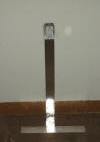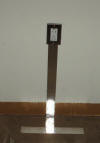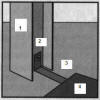 UNITED Static Control Products Contact us | Telephone 719 676 3928 | Search |
|
|
|
ELECTRICAL GROUNDING OF ESD FLOORSFor use with ElectraGuard, ElectraSeal, ESD Glue Down Tiles, Interlocking ESD Tiles, ESD Carpet Tiles and ESD Sheet VinylDownload these Grounding Instructions as a pdf file All ESD flooring material must be grounded to allow the electrostatic charges to flow to ground. The following methods provide easy, secure connections for attaching an ESD flooring to electrical ground. Note: Our ESD flooring requires 2 ground connections for small floors (under 3,000 sf) and one additional ground for every 3,000 sf thereafter. Note: More grounding attachments will not raise the conductivity of your flooring system or provide increased static control properties.
MOST COMMON METHOD:
1) Locate AC power outlet. Note: De energizing the outlet is highly recommended. Remove the center screw of the AC electrical face plate cover (this cover is typically plastic). Carefully remove the face plate. Starting at the AC outlet drywall cutout, run a piece of our 2" wide aluminum foil ground tape down the wall and onto the VERY CLEAN and DUST FREE concrete (or other flooring substrate) for about 4 to 6 inches. Note: Use an L square to insure the strip is straight. Click to expand photo.
Note: for a great looking attachment cut any wall base, peel back base and run strip behind the re-glued wall-base.
2) Run another aluminum foil strip (approximately 6" to 12” long) over this 2" or 3" piece that you've placed on the floor. Run this strip parallel to the wall and adhere to the flooring substrate (concrete, VCT, etc).
For Coatings: Lightly sand the foil on the floor with 320 grit emery paper or course scotch bright. Remove abrasive residue with a clean piece of paper towel. Apply the coatings over this strip.
For Glue Down Tiles and Sheet Vinyl: Cover the foil that has been applied to the subfloor with the conductive adhesive, place the tile or sheet vinyl over this adhesive and ground strip and roll with a 100 pound vinyl roller.
For Interlocking Tiles: Place the interlocker over the aluminum foil that has been applied to the subfloor.
For ESD Carpet Tile: Cover the foil that has been applied to the subfloor with the conductive adhesive, place the carpet tile over the adhesive and ground strip and roll with a 100 pound vinyl roller.
All materials: Replace the plastic AC electrical face plate cover with a metal face plate cover making sure metal face plate cover contacts the aluminum strip. Click to expand photo.
Your floor is now grounded. The ground foil on the wall may be painted if desired.
The way it works: The electrostatic charge flows across and through the flooring to the aluminum strip placed parallel to the wall. The Electrostatic charge flows up the strip (placed on the wall) through the metal face plate cover and to the buildings electrical ground system via the center screw of the AC electrical face plate cover.
. OTHER METHODS: Copper ground rods are often used in Military and Munitions environments and are not typical (nor normally recommended) for electronic manufacturing. Simply remove oxidation from rod, wrap tape as shown, clean up ground by installing aluminum pad, clean oxidation from pad and coat with paint or trowel over with conductive adhesives. Click to expand photo.
In this sketch a steel column (1) is used as an attachment point (2) for the aluminum ground foil (3) for subsequent application of ESD flooring adhesive, interlocking (no adhesive ESD tiles or coatings (4).
Simply remove rust from steel column via grinding or scraping, run foil down column, onto concrete and coat or trowel adhesive. The best connection is made by center punching the strap into the steel column in 4 or 5 places (this drives the aluminum foil into the steel column). Click to expand photo.
Contact United Static Control Products! Tame the Static Beast Before it Takes another Byte! © 1996 - 2025 All rights Reserved This page last Updated on 04/11/2025 |
||||||


